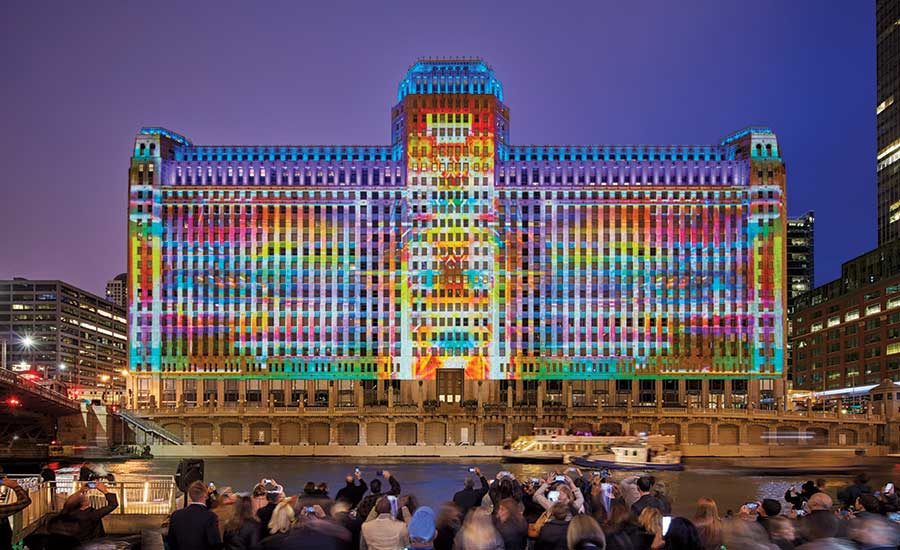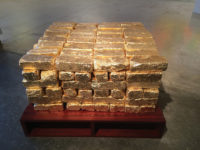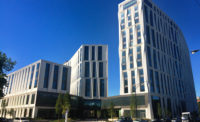The silvery, room-sized box peeking out from the Chicago Riverwalk’s limestone balustrade is perhaps the least obvious and scrutinized part of this new spine of green space, which is changing how the city considers its other great waterfront. As the projection room for a video-art installation beaming images onto the gargantuan expanse of the Merchandise Mart across the river, “Its design had to blend into the background,” says architect Mark Dewalt, of Valerio Dewalt Train Associates (VDTA), who designed the structure.
Additional Content:
Jump to credits & specifications
“You wouldn’t even notice it unless someone pointed it out for you,” says Will Chase, of Obscura, the digital art and media company that partnered with VDTA to create it. But there’s no missing the installation this structure enables. In its first week, hundreds of Chicagoans lined the Riverwalk to see the world’s largest permanent digital art projection, currently showcasing the works of four different artists.
Art on the Mart comes with a historically superlative canvas for the show. Chicago’s Merchandise Mart was the largest building in the world when it was completed in 1930. At 340 feet tall, it offers 91,000 square feet (more than two acres) of facade as a projection screen. The show will run five nights a week, 10 months of the year, for 30 years. Vornado Realty paid $8 million for the entire endeavor, delivered with no advertisement or branding, adding yet another experience to the Riverwalk’s amenity parade of public sculpture, restaurants, and wine bars.
But the size of this installation is a counterweight to the diminutive dimensions of the projector box that contains its equipment, and a lack of space was the most intense technical challenge faced by designers. The projection room contains 34 Christie Boxer projectors, each about the size of a toddler but weighing 300 pounds and trailed by air ventilation-exhaust tubes. This cozy space (about 800 square feet) is hemmed in by clearance for pedestrians below on the Riverwalk and by Upper Wacker Drive, which runs above it. Clad in reflective zinc, its steel structure cantilevers over the Riverwalk, slotting into its retaining wall. “There’s no fluff or extra space left,” says Dewalt. “The tolerances,” says Chase, “were down to a half inch or less.”
The permanent nature of this installation also provided maintenance and management challenges. For instance, Obscura custom-built a content-management system so that Art on the Mart staff can upload any video art they wish, by themselves. They and the architects tested 15 kinds of glass for transparency and durability, to stand up to the intense weather cycles of Chicago’s seasons, settling on a double-paned low-iron ultratransparent glazing that prevents the collection of condensation.
Accessed via a stairstep ladder, the projection room is filled with the exhaust tubes, which are wrapped in chrome-toned insulation and hang like thick, fleshy tendrils. The projectors are stacked on a steel rack that can be cranked to provide 30 inches of space for maintenance staff to clean in. Afterward, the projectors have to be digitally recalibrated.
“It’s extremely precise, because if the projector is off by a millimeter, by the time if gets across the river it [could be] a foot, and you’d see a lot of distortion and blurriness,” says VDTA’s Heather Salisbury, the installtion’s project manager.
This rack is set on rubber footings that protect against vibrations emanating from the nearby “el” train and traffic on Wacker Drive. The ventilation units are hung from the ceiling with spring assemblies, which also dampen vibration.
Obscura digitally mapped the entire Merchandise Mart’s southern face, so that the show’s programming wouldn’t shine a single light into the facade’s 1,000-plus windows. As to the show itself, the projector array proves able to render images in sharp, digital abstraction; in photo-realistic documentary video; and in Impressionistic, flowing strokes. The most effective sections of the inaugural run, which opened on September 29, use the sheer scale of the Merchandise Mart to communicate subtle bits of narrative, like a red harvest moon that quietly drifts across the horizon while all manner of plant life explosively envelopes this iconic Chicago building in the painterly effects of Jan Tichy’s Artes in Horto—Seven Gardens for Chicago. Conversely, Jason Salavon’s Homage in Between (Chicago Art, 20th Century) is native to our era of algorithmic aggregation and collage: a stream of paintings, illustrations, and photographs—from artists with strong Chicago connections—broken down to their component parts and montaged into digital psychedelia. In a city that steadfastly takes well-deserved pride in its architecture, it’s a new reason to keep looking up.
CreditsArchitect: Valerio Dewalt Train Associates—Mark Dewalt, prinicpal; Heather Salisbury, architect; Susan Crockett, design team
Creative studio: Obscura Digital
Engineering: IMEG
General contractor: Berglund Construction |
SpecificationsMetal panels Rheinzink
Glass Prelco (art glass)
Curtain wall Oldcastle BuildingEnvelope
Lighting Protean; Lithonia (interior); Eaton (exterior)
Doors Assa Abloy; Nystrom; Acudor
Hardware Schlage; Norton
Ceilings USG |







